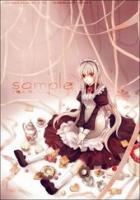The proximity of the proposed new structure to historic Independence Hall and the adjacent buildings would make it a focal point for visitors from all parts of the country and the world.The opportunity presented itself to put good art, within the comprehension of a large public, into the new building, and Bok asked permission of Mr.Curtis to introduce a strong note of mural decoration.The idea commended itself to Mr.Curtis as adding an attraction to the building and a contribution to public art.
The great public dining-room, seating over seven hundred persons, on the top floor of the building, affording unusual lighting facilities, was first selected; and Maxfield Parrish was engaged to paint a series of seventeen panels to fill the large spaces between the windows and an unusually large wall space at the end of the room.Parrish contracted to give up all other work and devote himself to the commission which attracted him greatly.
For over a year he made sketches, and finally the theme was decided upon: a bevy of youths and maidens in gala costume, on their way through gardens and along terraces to a great fete, with pierrots and dancers and musicians on the main wall space.It was to be a picture of happy youth and sunny gladness.Five years after the conception of the idea the final panel was finished and installed in the dining-room, where the series has since been admired by the thirty to fifty thousand visitors who come to the Curtis Building each year from foreign lands and from every State in America.No other scheme of mural decoration was ever planned on so large a scale for a commercial building, or so successfully carried out.
The great wall space of over one thousand square feet, unobstructed by a single column, in the main foyer of the building was decided upon as the place for the pivotal note to be struck by some mural artist.After looking carefully over the field, Bok finally decided upon Edwin A.
Abbey.He took a steamer and visited Abbey in his English home.The artist was working on his canvases for the State capitol at Harrisburg, and it was agreed that the commission for the Curtis Building was to follow the completion of the State work.
"What subject have you in mind?" asked Abbey.
"None," replied Bok."That is left entirely to you."The artist and his wife looked at each other in bewilderment.
"Rather unusual," commented Abbey."You have nothing in mind at all?""Nothing, except to get the best piece of work you have ever done," was the assurance.
Poor Abbey! His life had been made so tortuous by suggestions, ideas, yes, demands made upon him in the work of the Harrisburg panels upon which he was engaged, that a commission in which he was to have free scope, his brush full leeway, with no one making suggestions but himself and Mrs.Abbey, seemed like a dream.When he explained this, Bok assured him that was exactly what he was offering him: a piece of work, the subject to be his own selection, with the assurance of absolute liberty to carry out his own ideas.Never was an artist more elated.
"Then, I'll give you the best piece of work of my life," said Abbey.
"Perhaps there is some subject which you have long wished to paint rather than any other," asked Bok, "that might fit our purpose admirably?"There was: a theme that he had started as a fresco for Mrs.Abbey's bedroom.But it would not answer this purpose at all, although he confessed he would rather paint it than any subject in the realm of all literature and art.
"And the subject?" asked Bok.
"The Grove of Academe," replied Abbey, and the eyes of the artist and his wife were riveted on the editor.
"With Plato and his disciples?" asked Bok.
"The same," said Abbey."But you see it wouldn't fit.""Wouldn't fit?" echoed Bok."Why, it's the very thing."Abbey and his wife were now like two happy children.Mrs.Abbey fetched the sketches which her husband had begun years ago, and when Bok saw them he was delighted.He realized at once that conditions and choice would conspire to produce Abbey's greatest piece of mural work.
The arrangements were quickly settled; the Curtis architect had accompanied Bok to explain the architectural possibilities to Abbey, and when the artist bade good-by to the two at the railroad station, his last words were:
"Bok, you are going to get the best Abbey in the world."And Mrs.Abbey echoed the prophecy!
But Fate intervened.On the day after Abbey had stretched his great canvas in Sargent's studio in London, expecting to begin his work the following week, he suddenly passed away, and what would, in all likelihood, have been Edwin Abbey's mural masterpiece was lost to the world.
Assured of Mrs.Abbey's willingness to have another artist take the theme of the Grove of Academe and carry it out as a mural decoration, Bok turned to Howard Pyle.He knew Pyle had made a study of Plato, and believed that, with his knowledge and love of the work of the Athenian philosopher, a good decoration would result.Pyle was then in Italy; Bok telephoned the painter's home in Wilmington, Delaware, to get his address, only to be told that an hour earlier word had been received by the family that Pyle had been fatally stricken the day before.














